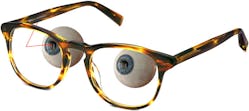There is limited information on Intel’s Vaunt augmented reality (AR) glasses, but essentially it uses a laser housed in the to generate an image directly on a person’s retina (see figure). This is in contrast to many other AR glasses that project an image in front of the eye.
Intel uses a very low power, vertical-cavity surface-emitting laser (VCSEL). The monochrome image is only about 400 × 150 pixels, but that is sufficient to provide text and limited graphics. Most other AR glasses are going in the other direction, with higher resolution and a wider field of view like ones from Realmax. Google Glass has a 640 × 360 pixel color screen.
The laser is mounted in the stem of the glasses. The electronics and battery are in the other stem. The advantage to this is full day operation without recharging. Also, the user needs to look down about 15 deg. to see the display that does not obstruct normal, straight-ahead viewing. The system also includes an accelerometer and compass so it is possible to track head movement. A microphone will be in the final version, allowing voice commands to be used as well.
Intel’s Vaunt augmented reality glasses use a laser to generate an image directly on a person’s retina, reflecting the light using the right lens on a set of eyeglasses.
The glasses actually need to configured for a user, as the laser is properly aligned. This is on par with measuring prescription glasses.
Vaunt currently lacks a camera like Google Glass and other AR glasses. A camera can extend the types of applications that AR glasses can handle, but it also reduces battery life. It also tends to be a bit bulkier and more noticeable by third parties.
Vaunt takes a more minimalist approach. Its compact size allows it to be essentially unnoticeable by others, and the limited viewing space tends to be less distracting to the user.
Javascript is used to control the display of content. The small size means even text will likely be streamed in small nuggets, but it will be easier to view than taking a look at a smartphone or smartwatch.
Another advantage will likely be price. The simpler system has lower functionality, but costs less. It is also easily applied to prescription glasses, as well.
All of that being said, Vaunt is a project, and Intel has terminated many projects for various reasons. For example, Intel decided not to release is Project Alloy virtual reality (VR) system.
AR technology is still in its infancy. It is unlikely that one approach will meet all needs, but platforms like Vaunt will likely gain traction if supported by a major player such as Intel.


